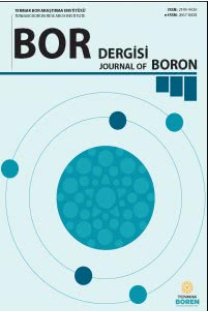Surface modification of anhydrous borax powders with stearic acid via mechanical dry powder coating
Anhydrous borax Stearic acid, Surface modification, Dry Coating,
___
- [1] McMillian P. W., Glass-Ceramics, 2nd Edition, Academic Press, New York, 1979.
- [2] Kingery W. D., Bowen H. K., Uhlmann, D. R., Introduction to Ceramics, John Wiley and Sons, New York, 1976.
- [3] Hawthorne F. C., Burns P. C., Grice J. D., The crystal chemistry of boron. In Boron Mineralogy, Petrology and Geology (E. S. Grew and L. M. Anevitz, Eds.), Mineral Society American, MSA Reviews in Mineralogy, 33 (2), 41-116, 1996.
- [4] Helvaci C. Borates, in Encyclopedia of Geology, (Selley R.C., Cocks, L.R.M and Plimer, I.R., eds.), Elsevier, (3), 510-522, 2005.
- [5] Kirk-Othmer, Encyclopedia of Chemical Technology, Ch.4, 5th Edition, 241-294, 2004.
- [6] Akpinar S., Yazici Z.O., Can M.F., Investigation of surface-modified anhydrous borax utilisation in raw glazes, Ceram. Int 44, 18344–18351, 2018.
- [7] ECETOC Technical Report No. 63, Reproductive and General Toxicology of Some Inorganic Borates and Risks Assessment for Human Beings, European Centre for Ecotoxicology and Toxicology of Chemicals (ECETOC), Brussels, Belgium, 3, 1995.
- [8] Kaplan J., Zamek J., A substitute for gerstley borate, Ceramics Technical, 32, 24-29, 2011.
- [9] Otles M. S., Modification of surface properties of biopowders by dry particle coating, Ph.D. Thesis, Université de Toulouse, National Institute of Posts and Telecommunications, Rabat, 2008.
- [10] Pfeffer R., Dave R. N., Dongguang W., Ramlakhan M., Synthesis of engineered particulates with tailored properties using dry particle coating, Powder Technol., 117, pp.40-67, 2001.
- [11] Yoshihara I., Pieper W., Hybridization–technology for surface modification of powders without binders, Swiss Pharma 6, 21, 1999.
- [12] Ouabbas Y., Chamayou A., Galet L., Baron M., Thomas G., Grosseau P., Guilhot B., Surface modification of silica particles by dry coating: Characterization and powder ageing, Powder Technol., 190a, 200-209, 2009.
- [13] Lefebvre G., Galet L., Chamayou A., Dry coating of talc particles: Effect of material and process modifications on their wettability and dispersibility, AIChE Journal, 57 (1), 79-86, 2011.
- [14] Sonoda R., Horibe M., Oshima T., Iwasaki T., Watano S., Improvement of dissolution property of poorly water-soluble drug by novel dry coating method using planetary ball mill, Chem. Pharm. Bull. 56 (9),1243-7, 2008.
- [15] Tsai W. T., Microstructural characterization of calcite-based powder materials prepared by planetary ball milling, Materials, 6, 3361-3372, 2013.
- [16] Suryanarayana C., Mechanical alloying and milling, Prog. Mater Sci., 46, 1–184, 2001.
- [17] Baláž P., Mechanochemistry in Nanoscience and Minerals Engineering, Chapter 2, High Energy Milling, Springer, Hardcover, Netherland, 2008.
- [18] Hersey J. A., Ordered mixing: A new concept in powder mixing practice, Powder Technology, 11 (1) 41-44, 1975.
- [19] Dahmash J., Dry particle coating-a unique solution for pharmaceutical formulation, Pharmaceutical Technology, 42 (3) 26-30, 2018.
- [20] Gilbert M., Petiraksakul P., Mathieson I., Characterization of stearate-stearic acid coated fillers, Mater. Sci. Technol., (17), 1472–1478, 2001.
- [21] Jeong S. B., Yang, Y. C., Chae Y.B., Kim B. G., Characteristics of the treated ground calcium carbonate powder with stearic acid using the dry process coating system, Mater. Trans., 50 (2), 409–414, 2009.
- [22] Mihajlovic S. R., Vucinic D. R., Sekulic Z. T., Milicevic S. Z., Kolonja B. M., Mechanism of stearic acid adsorption to calcite, Powder Technol., 245, 208–216, 2013.
- [23] Gilbert M., Sutherland I., Guest A., Characterization of coated particulate fillers, J. Mater. Sci., 35, 391–397, 2000.
- [24] Griffin M., The Structure and Biological Functions of Lipids, Bio Factsheets, 3, 2000.
- [25] Markley K. S., Fatly Acids: Their chemistry and physical properties, Part 1, 2nd ed., Interscience Publishers Inc., New York. 1960. [26] Agernäs O., Tengberg T., Development of two methods to evaluate lubricating greases using a rheometer, B.Sc. Thesis in Chemical Engineering, Chalmers University of Technology, Göteborg, Sweden, 2011.
- [27] Hashmi S., Effect of surface roughness on wetting properties, in Comprehensive Materials Finishing, 285, 2017.
- [28] Kanimozhi D., Ratha Bai V., Analysis of bioactive components of ethanolic extract of coriandrum sativum L., IJRPS 2012, 2 (3),97-110, 2012.
- [29] Jeong S. B., Yang Y. C., Chae Y. B., Kim B. G., Characteristics of the treated ground calcium carbonate powder with stearic acid using the dry process coating system, Mater. Trans., (50–2), 409 - 414, 2009.
- [30] Liao J., Du G., Qiao X., Hao D., Surface modification of diatomite by stearic acid and its effects on reinforcing for natural rubber/styrene-butadiene rubber blend. J. Chin. Ceram Soc., (39), 641-645, 2011 . [31] Wang Y., Lee W. C., Characterization and treatment of calcium carbonate: A comparative study, Polym. Compos., (24), 119–131, 2003.
- [32] Wang B. B., Feng J. T., Zhao Y. P., Yu T. X., Fabrication of novel superhydrophobic surfaces and water droplet bouncing behavior, J. Adhes. Sci. Technol., 24, 2693-2705, 2010.
- ISSN: 2149-9020
- Yayın Aralığı: 4
- Başlangıç: 2016
- Yayıncı: TENMAK Bor Araştırma Enstitüsü
A critical review on the determination of boron in various matrices
Argun Türker, Ali Rehber Türker
Synthesis and characterization of Mn2 B nanocrystals by mechanical alloying method
Tuncay Şimşek, Şadan Özcan, Telem Şimşek
Seyit Ali DURSUN, Fariz MİKAİLSOY
Kubilay KARACİF, Cemal ÇARBOĞA, Duygu CANDEMİR
Süleyman AKPINAR, Zeyni ARSOY, R. Sena ŞENOL
Gülşah AKINCIOĞLU, Sıtkı AKINCIOĞLU, İlyas UYGUR, Hasan ÖKTEM
Niyazi Yılmaz ÇOLAK, Hüseyin TURHAN
Tuncay ŞİMŞEK, Telem ŞİMŞEK, Şadan ÖZCAN
Argun TÜRKER, Ali Rehber TÜRKER
Polivinil borat/TiO2 nanokompozitlerin UVA ve doğal güneş işığı altındaki fotokataliz uygulaması
